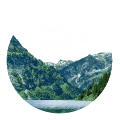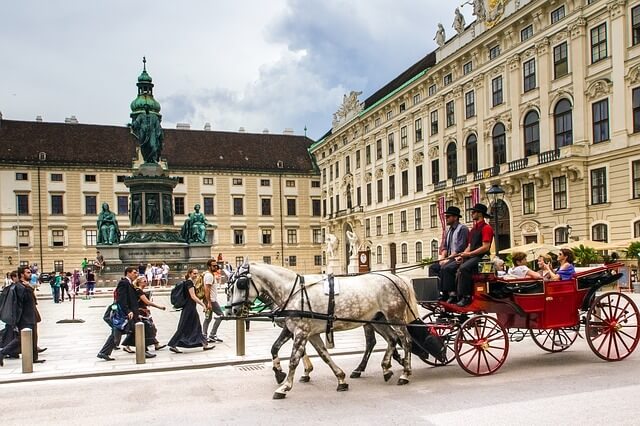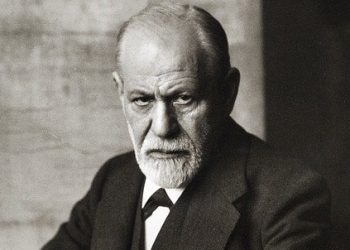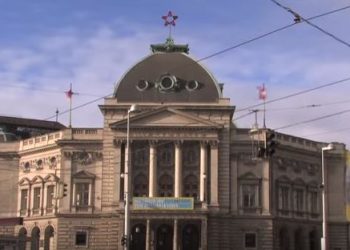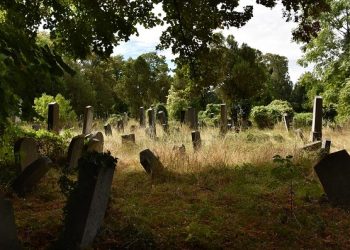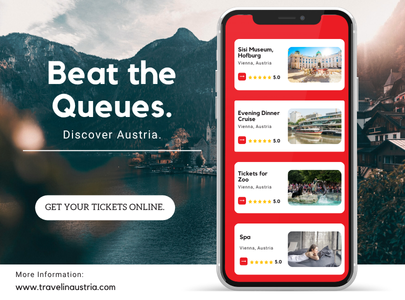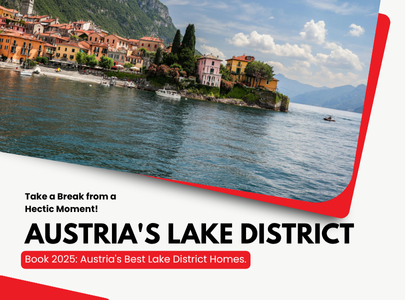The article on Vienna is particularly comprehensive and includes extensive information on recommended accommodation areas, attractions, and many essential tips to ensure you are as prepared as possible for your trip.
To make navigating through the wealth of information easier, you can use the table of contents below. Clicking on the links in the table of contents will take you to the desired section of the article.
- General information about Vienna
- Public transportation and arrival from the airport and back
- Car rental
- Must-see attractions in Vienna
- Recommended attractions for children
- Classical Concerts
- Mozart, Strauss, Beethoven and more
- Vienna tourist bus – hop on hop off
- Additional tips for a fun and comprehensive trip:
- Shopping
- Nightlife
- The Viennese culinary world
- Urban nature
- Tours and day trips outside Vienna
- Interactive map
- Other recommendations
The City of Vienna – What Makes it So Special?
Vienna (German: Wien), the capital city of Austria, is the largest city in the country. About 1.9 million residents live in the city itself, and another million residents live in its suburbs (almost a third of Austria’s entire population lives in greater Vienna!). The city of Vienna is not located in the heart of Austria but rather in its northeastern part, close to the borders with Slovakia, Czech Republic, and Hungary. Even though the city has grown rapidly over the years, locals still see it as a small village where everything is close and accessible, and everyone knows everyone. Thanks to the excellent public transportion of the city, everything is indeed close and accessible; this will be explained further later in the article.
Vienna’s character differs from many capital cities across the continent. It is a city with a calm, classic, and well-maintained character. The city is clean, boasts centuries-old buildings beautifully and elegantly preserved, and many world-renowned cultural institutions. The cobblestone streets of the city center, combined with the horse-drawn carriages that traverse them throughout the day, definitely create a charming atmosphere of stepping back in time. Moreover, the city is steeped in greenery, and in every corner of the city, you can find spacious parks where you can stroll peacefully and enjoy the fresh air. Of course, like any big city, there’s nightlife and entertainment areas, but even these possess a style characteristic of the local flair. Another unique characteristic of Vienna is its ancient coffee house culture, something definitely nice to discover and experience.
A Short City-break? Definitely Worth It!
Since the city is not that large and most of its important attractions are concentrated in the central area, you can plan a comprehensive and relaxed 3-4 day vacation in the city. We have specially prepared a detailed itinerary for a three or four-day trip with an interactive map. There is no doubt that even a short visit to the city will allow you to understand why it is repeatedly chosen as the place with the highest quality of life in the world.
The city also has a large and active Jewish community. The community, which was severely affected during the Holocaust and almost completely wiped out, has restored its former glory and openly brings Jewish life in Vienna back to its splendor. Kosher observers will find Vienna a convenient place to visit, especially due to its active synagogues, an eruv throughout the city center, a kosher hotel, a wide variety of kosher restaurants, and extensive Jewish activity. Even the large Friday night dinners at Chabad House have become a recommended attraction if you are visiting for a weekend in the city.
There is no doubt, then, that a trip to Vienna is definitely a wise choice! Here you will discover a classic and particularly impressive world. Many activities, attractions, and interesting places await you in Austria’s beautiful capital. By the way, before the flight, it is advisable to go over some things you must know before arriving in Austria.
What to Do in Vienna in Summer and Winter?
The winter months in Vienna are characterized by a more romantic atmosphere with wonderful decorations, the magnificent Christmas markets, and New Year celebrations. Afterwards, in the cold months of January and February, the atmosphere in the city is calm and sleepy. This is the ball season, where you can peacefully enjoy the classic character of the city. In summer, the heart of the city is bustling with life, and there are many wonderful events and opportunities to enjoy the wonderful urban nature (we will elaborate on this later).
Before we go into detail about the important attractions in the city, it is worth first understanding where the important districts are, including the location of the city center, how to get around the city easily, and how to find the best location for accommodation in the city center.
Vienna’s Districts – How the City is Divided and Where the Main Attractions Are?
Administratively, Vienna is divided into 23 districts (in German: Wiener Gemeindebezirk), and each district is numbered accordingly. The establishment of the districts began in 1850 and resulted from the city’s rapid expansion and the annexation of additional areas that were once independent villages.
Locals tend to refer to places in the city by their location in a specific district, so it’s useful to know how to identify the different districts. In addition, some restaurants, for example, have multiple branches, and the easiest way to know if you’re going to the right place is to check the district they are located in. The best way to identify which district you are in is to look at the street signs. Before each street name, there is a number symbolizing the district it is in. There are places in Vienna where one side of the street is in one district and the other side is in a different district. You can easily identify this by checking the street signs. For example: the street in the picture is in the 7th district.

Map of Vienna’s District Division:
In the map below, you can clearly see how the city is divided and the location of all the districts. District number 1, the first district, is the central district where the Old City is located. As you can see, there are many small districts surrounding the first district, and together they are considered the heart of the city. There are attractions in almost every district. We will elaborate on this later in the article.
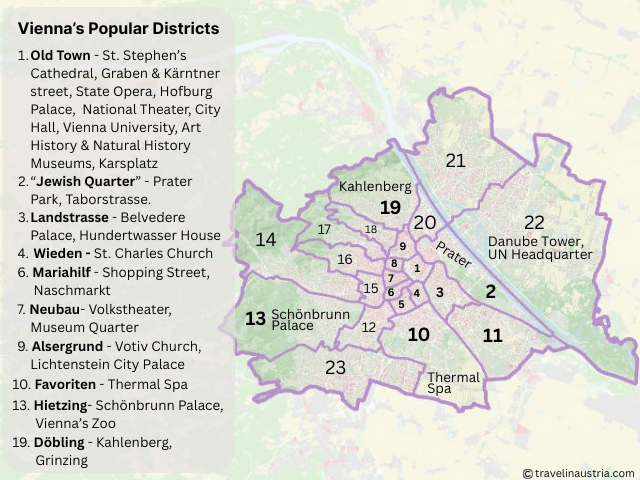
Where is the City Center of Vienna?
In short: The heart of the city is the first district (1st District), called Innere Stadt in German.
Why is the city center not located on the banks of the Danube River?
In most European cities, the city center is located right on the banks of the large river flowing through them. This is not surprising given that in the past, rivers were an important source for transporting goods and people, as well as for drinking, bathing, and so on. In Vienna, unlike cities like London or Amsterdam, the mighty river does not pass through the center, but flows in the eastern part of the city (although there is the Danube Canal, it is very small and is not used for commerce or traffic).
The main reason why the city was not established around the mighty Danube River is the frequent floods and erosion. For many years, the river would overflow its banks and flood parts of the city (the Jewish Quarter was one of the regularly flooded districts, and this is one of the reasons why Jews were sent to live there). To prevent the floods, dams were built and even an entire artificial island – Danube Island – 21 kilometers long. Therefore, when looking at a map and trying to identify the city center, one should not rely on the flow of the Danube River.
How to easily identify Vienna’s city center on Google Maps?
The city center is District 1, located exactly in the geographical center of the city and surrounded by all other districts. You can see its marking in the map image below. This district is bounded by a central street called the Ringstrasse, which encircles it like a ring on all sides (hence its name).
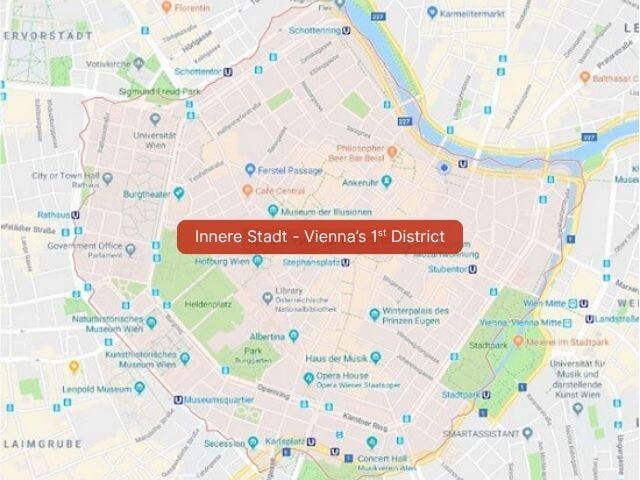
You can identify the location of the district by identifying the Ringstrasse on the map or by mapping the area bounded by the Danube Canal (Donaukanal) to the north, Hofburg Palace to the southwest, and Stadtpark to the southeast.
The first district of Vienna is characterized by ancient streets, paved with small stones as befits an old city. In its center is the famous St. Stephen’s Cathedral, and around it there are streets full of luxury shops, restaurants, and coffee houses.
If you are looking for recommended accommodation in the city center, it is always advisable to choose a place close to a subway station. This will greatly facilitate getting around the city to distant attractions such as Schönbrunn Palace, Kahlenberg Mountain, or Vienna Spa.
There are several subway stations located in District 1. Metro lines are marked with different colors to make it easier to find the desired line. The stations are:
- Stephansplatz – U1, U3
- Stubentor – U3
- Schwedenplatz – U1, U4
- Karlsplatz – U1, U2, U4
- Schottenring – U2, U4
- Herrengasse – U3
Recommended Districts for Accommodation in Vienna [Besides District 1]
Besides the 1st District, which is truly the heart of the city and also the more expensive area for accommodation, there are some other districts that are considered by locals a part of the city center and are excellent for accommodation as well.
The recommended districts are:
- The Jewish Quarter (District 2) in the part closest to the Danube Canal and the Schwedenplatz area. Read about recommended hotels in District 2 in the Jewish Quarter.
- Landstrasse (District 3), where the Wien Mitte subway station is located, from which the train arrives from Vienna Airport, as well as Belvedere Palace and Hundertwasser House.
- Wieden (District 4), where Karlskirche and Resselpark are located.
- Mariahilf (District 6), where Naschmarkt and Mariahilfer shopping street are located. You can stay there quite cheaply.
- Neubau (District 7), where part of Mariahilfer shopping street and the Museum Quarter are located. Read about recommended hotels in the Mariahilfer shopping street area.
- Josefstadt (District 8), located behind the City Hall, with ancient and quiet streets.
- Alsergrund (District 9), where Votivkirche is located.
If you choose a hotel or an apartment in one of these districts, you have made a good choice. Just make sure to choose a place which is close to a subway, and accessing the city’s main attractions.
Important to know: Tips for choosing a hotel or apartment
When you search for accommodation or attractions on Google, you will see next to each address its postcode, written in this format: 1010. The district number is only the two middle digits. In the example we wrote, the district is 01 – the first district of Vienna. This way you can know which district you are staying in and what are the closest attractions to you. Look at the city map we prepared to understand the location of the attractions around the city.
Since there are many accommodation options in Vienna, it is advisable to use the list of hotels and apartments in Vienna recommended by other travelers. We have compiled the recommendations from our Facebook groups. The recommended places are near the city center and also in the Jewish Quarter and Chabad House area.
Public Transportation in Vienna – Do you even need a car in the city?
Vienna is truly accessible, thanks to an excellent public transport system. The extensive transport system includes subways, trams, and buses. This combination allows for simple and fast arrival to almost every corner of the city – day and night. Throughout the week there are night lines, and on Saturdays, Sundays, and holidays, the subway runs continuously all night.
Within the city, there is no need for a car at all, and it is even recommended to avoid it. All you need is to download the WienMobil app and purchase a daily/weekly free ticket that allows unlimited travel on all public transport in the city. A detailed explanation of Vienna’s public transport system, including details of ticket prices and recommendations, can be read in the detailed guide we have prepared on getting around by public transport in Vienna with ease.
How to get to the city from Vienna International Airport?
The international airport is located south of the city. About a 20-minute drive from the center. There is also excellent public transport from the airport that includes several trains and buses to ensure there is a way to get to and from the airport at all hours of the day. We have compiled in a separate article the 6 ways to get to and from the airport.
Renting a Car in Vienna (or at Vienna International Airport)
If you are coming for a short visit to the city, there is no reason to rent a car since public transportation within the city is excellent. On the other hand, the city of Vienna also serves as a starting point for multi-week trips throughout the country. Due to the long distances within the country, and the scarcity of public transport in the various villages, you must rent a car to make the most of it. At Vienna Airport and also in the city center there are a variety of car rental companies – some international and some local. Due to the increasing demand for cars for travel, there are new companies popping up all the time. We have compiled in a separate article with recommendations and information regarding car rental in Vienna and also tips for saving on car rental through a recommended Slovak company. What is important to remember is that the availability of cars, especially minivans, runs out quickly. In addition, there are not many automatic cars available, so if you must have an automatic minivan, it is advisable to book well in advance (even 8 months in advance).
What are the must-see attractions in Vienna?
This section provides a comprehensive overview of the attractions around the city, divided according to the districts in which they are located. If you don’t want to waste too much time planning your itinerary in Vienna, you can use the detailed itinerary we have prepared for a multi-day trip in the city. The itinerary includes attractions, restaurants, and also a map with markings of the places in the recommended itinerary. Read about the itinerary for a multi-day trip to Vienna.
After the general overview, there is an additional focused breakdown of recommended attractions for children if you are planning a family trip to the city.
Must-See Attractions in Vienna
As you saw in the map of Vienna’s districts at the beginning of the article, only a small number of districts in Vienna include significant and beautiful attractions worth seeing during your first visit to the city. In this section, we will detail the important districts of the city and the recommended attractions located within them, such as:
The Old City (District 1):
- Hofburg Palace
- St. Stephen’s Cathedral
- State Opera House
- Museum Quarter
- Central Synagogue of Vienna
- City Hall
- Austrian Parliament
- Spanish Riding School
- National Library
- Natural History Museum
- Albertina Museum
The Jewish Quarter (District 2):
- Chabad House
- Jewish Street – Taborstrasse
- Prater Amusement Park
- Madame Tussauds Wax Museum
- Augarten Park
District 10:
- Vienna’s Thermal Spa in Oberlaa
District 4:
District 13:
District 19:
- Kahlenberg Mountain and the viewing platform of Vienna.
Of course, there are other excellent attractions throughout the city located in various other districts. You can read extensively about these attractions in the details below. By clicking on the red buttons, you can read information about 37 excellent attractions in the city. Afterwards, there is a list of recommended attractions for children and also many more tips for your trip! Keep reading, and by the end of the article, you will definitely be ready for your visit to Vienna.
Read more information about the recommended attractions in all the important districts of Vienna by clicking on the red buttons below:
District 1
The central district of Vienna and where the Old City is located. Most of the city’s important attractions are concentrated in this area.
District 2
The second district is known as the Matzosinsel (Matzo Island) district due to it being Vienna’s Jewish Quarter for centuries.
District 3
This district is located southeast of the Old City. The regional train station that arrives from Vienna Airport is located in this district.
District 4
Due to its proximity to the city center, it is considered popular. In this district are Karlsplatz square, adjacent to Naschmarkt in District 6.
District 6
This district offers good shopping opportunities with Naschmarkt and Mariahilfer shopping street. You can stay here quite cheaply.
District 7
Considered a very desirable place among students, intellectuals, and artists. The neighborhood is also full of foreigners from all over the world.
District 9
The buildings in this district are impressive and ancient, and it is considered popular among local young people. The University of Vienna campus is located in this district.
District 13
This district is quite far from the center, but it is still considered one of the most visited in the city. The magnificent Schönbrunn Palace and the ancient and royal zoo are located here.
District 19
This district is located in the northern part of the city and is surrounded by wonderful green areas and the Vienna Woods. The famous Kahlenberg Mountain is located in this district.
The Other Districts
To complete the overview of the city’s districts, you can find the rest of the city’s districts here.
Recommended Hotels and Apartments
We have compiled a list of hotels and apartments recommended by travelers in all the recommended areas of the city.
Recommended Attractions for Children in Vienna
If you are planning to fly with the whole family to Vienna, it is worth knowing about some entertainment places that children will love, in addition to the central attractions that are a must-see anyway (as we mentioned above).
Recommended attractions for children include:
- The Vienna Aquarium
- Museum of Illusions
- Vienna Zoo
- House of Music
- Prater Amusement Park
- Chocolate Museum
- Vienna Alpine Coaster
- Rope Park on Kahlenberg Mountain
- Museum of Technology
Classical Concerts – A True Viennese Experience!
Vienna is a very high-quality center for classical music. The greatest composers lived in the city, created, and performed in the magnificent concert halls throughout the city. Mozart, Beethoven, Strauss, Vivaldi, and others left their musical mark on the city, and their works continue to be performed almost every evening throughout the year.
When visiting Vienna, one of the best ways to experience the world of music and the classic character of the city is through a classical concert. The city has a variety of orchestras performing famous works in various concert halls, famous churches, and important palaces.
To make it easier for you to search for a suitable concert to enrich your trip, we have prepared a compiled list of recommended concerts in Vienna.
Vienna Tourist Bus – Hop On Hop Off
On cold or rainy days in Vienna, one of the most convenient and easiest ways to discover the city is by using the tourist bus. With a valid ticket, you can hop on and off at various stops freely and without limitation, and travel to different parts of the city effortlessly.
In Vienna, there are two bus companies that offer a variety of routes throughout the city, even to areas far from the center such as Schönbrunn Palace or the Grinzing neighborhood. One of these companies offers an audio guide option in Hebrew!
You can read comprehensive information about the Vienna tourist bus, including information on the different routes, ticket booking, and operating hours, in the extended article we have prepared on the Vienna tourist bus.
Additional Tips & Hints for an Enjoyable Trip to Vienna
Not only impressive attractions make Vienna attractive to many travelers. There are additional activities that will enrich your stay in the city.
Shopping in Vienna – A High-Quality European Shopping Experience
When you arrive in Vienna, you will see that it is undoubtedly a city with class and style. The various shops also offer a wide range of high-quality and beautiful products. Do not expect low prices, although they will still be lower than in Israel. In fact, throughout the city and its surroundings there are no less than 14 shopping complexes, whether in huge malls, in ancient streets in the heart of the city, or in markets. The good news for shopping lovers is that you can get a tax refund on purchases in Vienna!
We have compiled all the relevant information about the 14 shopping centers in Vienna and a guide to tax refunds in a separate article.
Vienna’s Nightlife
If you are looking for wild nightlife and non-stop parties, Vienna is probably not exactly the right destination for that. Vienna’s nightlife is quite sleepy, but of course it is impossible that in the capital of Austria there would be no experiential activity at all in the late hours of the night.
The center of the city’s nightlife is located in an area known as the “Bermuda Triangle” right next to Schwedenplatz square. In this place there are many pubs, bars and dance clubs. In the extended article we have prepared, you can read about recommended entertainment places in the Schwedenplatz area. In the summer months, the city’s youth go out to the Danube Canal and spend warm summer evenings along it. There are bars and restaurants along the canal.
If you are more into a classic and fancy evening out, you should check out the list of luxurious bars in the city. These are places where all the Who’s Who of Austria hang out.
Those who want to go out dancing a bit (mainly on weekends) can choose one of the various dance clubs located in the central districts of the city.
Viennese Cuisine – Is there anything to look forward to?
The restaurants in Vienna are diverse and numerous. As befits an international capital city, you can find restaurants with dishes from all over the world.
Austrian cuisine is mainly known for the Wiener Schnitzel that everyone knows. Other Austrian dishes are goulash, Tafelspitz, and Knödel. It is possible that in some places in the city you will get the impression that the main dishes of Austrian cuisine are a bit bland, but this is something that can be easily solved by taking a culinary tour in Vienna to places that locals love.
Although the main dishes of the Austrians are not particularly impressive, the dessert menu is exceptional in its variety and flavors. Apple strudel, Kaiserschmarrn, Sacher cake, Linzer Torte are just a tiny fraction of the wide selection of desserts that the Austria has to offer. If you love sweets, Vienna will not bore you culinarily. You can visit a variety of Viennese coffee houses to drink local coffee, taste Austrian desserts, or soak up some of the Viennese atmosphere.
Urban Nature – Lots of Greenery and Fresh Air!
Vienna was recently crowned the greenest city in the world! And rightly so. The city is full of wonderful parks and is surrounded on all sides by green hills and vineyards. There is no doubt that the air quality in the city (outside the center) is excellent, especially if you venture out a bit to the natural areas on the outskirts of the city.
If you don’t want to exert yourself too much, you can stroll in the Stadtpark or visit the Volksgarten or the Burggarten located in the city center. Other wonderful natural areas can be found in Prater Park, Schönbrunn Palace, in the Danube Island area (which is about 21 kilometers long) or in the vineyard area surrounding Kahlenberg Mountain.
Nature lovers who prefer wilder landscapes are invited to enjoy the marked hiking trails that pass through the outskirts of the city and in the Vienna Woods area. Extended information about 11 hiking trails in the nature surrounding Vienna.
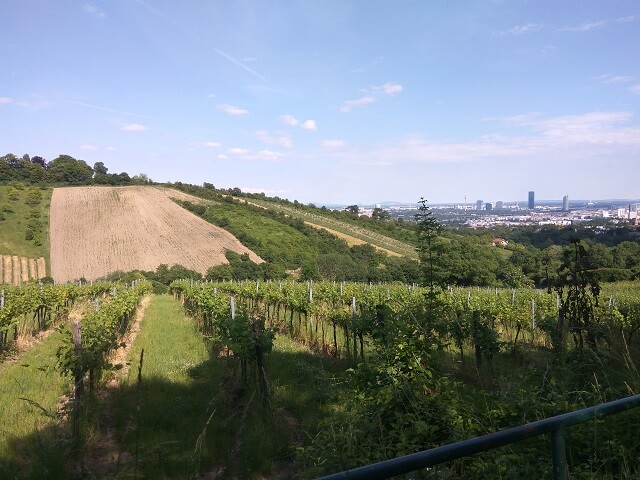
Tours and Day Trips Outside of Vienna
Within Vienna, you can join several guided tours which combine fascinating history and wonderful stories from life in the city. This is an educational way to get a glimpse into the city’s past and present.
If you are coming for than 3 days, or if you want to combine amazing nature with a city trip, you can join a day trip to one of the wonderful natural areas outside Vienna. You can choose between a day trip to the Lake District in Salzburg (the area where Hallstatt village is located), the Vienna Alps, the Wachau Valley, the capital of Slovakia Bratislava, or Hungary. If you are not afraid of long journeys, we can highly recommend the trip to Hallstatt.
Interactive Map of Vienna
The wide variety of attractions can be a bit confusing, so we have prepared a consolidated map of the city’s attractions, shopping areas, accommodation places, restaurants, and more (you can enlarge the map and view it on a full screen). With the help of the map, you can get a general overview of all the recommended places in Vienna. In the explanation for each attraction on the map, there is a link to the dedicated article about them on the website. You can view an enlarged map by clicking here.
Additional Recommendations for the Perfect Visit to Vienna
You can read about recommended accommodation, about the Jewish sites of Vienna, or about the excellent public transport in the city.
If you are coming to Vienna during the holiday season (Christmas and New Year), you must not miss the picturesque markets scattered throughout the city. In addition, we have 12 hot recommendations for a winter trip to the city. For those arriving in the summer months, we have prepared a compilation of 18 wonderful summer attractions especially for you.
If you have a few days in Vienna, you can dedicate one day to a nature and scenery trip outside the city. You can visit the Wachau Valley, the Vienna Alps, Burgenland, or pop over for a visit to beautiful cities in neighboring countries like Bratislava. You can read about the tours that we recommend.

